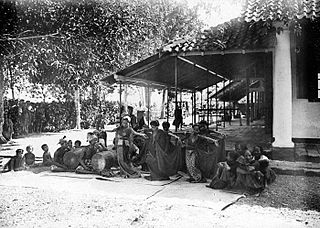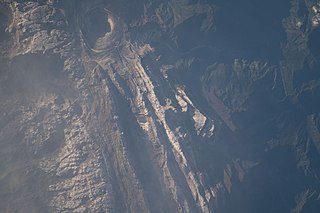The Amung people are a group of about 17,700 people living in the highlands of the Central Papua province of Indonesia. Most Amungme lives in Mimika and Puncak, in valleys like Noema, Tsinga, Hoeya, Bella, Alama, Aroanop, and Wa. A related group lives in Beoga Valley, Puncak and they are called Damal people.

Merauke Regency is a regency in the far south of the Indonesian province of South Papua. It covers an area of 45,025.91 km2, and had a population of 195,716 at the 2010 Census and 230,932 at the 2020 Census; the official estimate as at mid 2022 was 232,357, comprising 121,237 males and 111,120 females. The administrative centre is the town of Merauke; this was projected since 2013 to become an independent city (kota) separate from Merauke Regency, but the alteration has been deferred. It is also the provincial capital of the province of South Papua, more specifically in Salor located in Kurik District. Merauke is the largest regency in Indonesia, with an area of 45,026 km2, slightly larger than Estonia.

The Manggarai are an ethnic group found in western Flores in the East Nusa Tenggara province, Indonesia. Manggarai people are spread across three regencies in the province, namely the West Manggarai Regency, Manggarai Regency, and East Manggarai Regency.
In the anthropological study of kinship, a moiety is a descent group that coexists with only one other descent group within a society. In such cases, the community usually has unilineal descent so that any individual belongs to one of the two moiety groups by birth, and all marriages take place between members of opposite moieties. It is an exogamous clan system with only two clans.
Baham, also rendered Mbahaam, is a Papuan language spoken on the Bomberai Peninsula. It is closely related to the Iha language.

The Bonerate people are an ethnic group in South Sulawesi, Indonesia. They inhabit around the Selayar island group such as Bonerate, Madu, Kalaotoa, and Karompa islands.
The Aneuk Jamee or Ughang Jamu people are a Minangic-speaking ethnic group spread along the west and south coast of Aceh, starting from Singkil, South Aceh Regency, Southwest Aceh Regency and Simeulue Regency. The Aneuk Jamee people are originally Minangkabau people who have migrated to Aceh in the 19th century, and intermarried with the Acehnese people, Kluet people, Singkil people and Devayan people. In terms of language, the Anuek Jamee language is considered as a dialect of the Minangkabau language that has a mixture of Aceh's native languages.

Singkil people are an ethnic group of people found in Aceh Singkil Regency and Subulussalam, Aceh province, Indonesia.

The Alas people is an indigenous ethnic group from Kutacane, Southeast Aceh district, Sumatra, Indonesia. The Alas are found in the Gunung Leuser, Ketambe, and Alas River areas.

The Abui are an indigenous ethnic group residing on Alor Island, East Nusa Tenggara, Indonesia. Abui people are spread across the districts of South Alor, East Alor, and Northwest Alor in Alor Regency. Abui people speak the Abui language, which is a Papuan (non-Austronesian) language, as well as Indonesian, and a Malay-based creole known as Alor Malay.

Rotenese people are one of the native inhabitants of Rote Island, while part of them reside in Timor. Apart from that, the Rotenese people also settled in islands surrounding Rote Island, such as Ndao Island, Nuse Island, Pamana Island, Doo Island, Heliana Island, Landu Island, Manuk Island, and other smaller islands. There are some who believed that the Rotenese people originally migrated from Seram Island, Maluku. They were thought to have arrived on the Rote Island during the reign of the Majapahit kingdom in the late 13th-16th century. It was during this time that there were references to the rulers of the Rotenese people. Initially, the Rotenese people founded settlements on the island of Timor, where they engaged in manual slash-and-burn farming and used irrigation system.
Helong people are one of the indigenous inhabitants of Timor Island, in Indonesia. Most of them live in Kupang Regency, namely in West Kupang and Central Kupang; and some also settled in Flores Island and Semau Island. Their livelihoods are mainly farming, hunting, fishing, and making traditional crafts.

Bungku people are an ethnic group who mostly resides in North Bungku, South Bungku, Central Bungku, and Menui Islands districts di Morowali Regency, in Central Sulawesi province of Indonesia. This ethnic group is divided into several sub-groups, namely Lambatu, Epe, Ro'tua, Reta, and Wowoni. Bungku people have their own language, called Bungku language, which is one of their characteristic and serves as a means of communication between themselves. They generally embrace Islam or Christianity.

The Delis or Deli Malay people are a sub-ethnic group of Malays native to the eastern coast of North Sumatra, particularly in the Deli Serdang and Medan. The Deli culture began with the Sultanate of Deli, an Islamic kingdom established in North Sumatra from 1632 to 1946. Deli Malays are known for their famous pantoum art until today.
Marlina Flassy is an Indonesian anthropologist, who is the first woman to hold a deanship at Cenderawasih University, and is the first woman and indigenous Papuan to be appointed Dean of the Faculty of Social and Political Sciences there. In 2015 the Indonesian Ministry of Research and Technology awarded her its Golden Pin Award.
The Abun, previously also known as Wen and Karon, are an ethnic group of New Guinea, residing in the Sausapor district of the Tambrauw Regency in the province of Southwest Papua. They speak the Abun language. They live in the Sausapor, Jokte, Emaos and Uigwem villages of Sausapor and are of the clans Yekwam, Yenjau, Yeblo, Yesnath, Yenbra, Yenggrem, Yesomkor, Yerin, Yeror, Yewen, Yemam and Yesian.
Lembak people, also known as Linggau people, are a local ethnic group that inhabits several areas of Bengkulu Province and South Sumatra Province in Indonesia. Their original settlements are in the border area between the two provinces, in the Barisan mountain range, with densely clustered villages pattern.

On 2 March 2022, gunmen of the Free Papua Movement attacked and killed eight workers at a Telkomsel telecommunications facility in Beoga, Puncak Regency, in the Central Papua province of Indonesia.
The Wai Apu people are one of the native peoples of Buru island in Maluku, Indonesia, typically inhabiting the north-east of the island in what are now the Namlea and Waplau districts. Research from the Indonesian Ministry of Social Affairs in 1985 numbers the Wai Apu population at approximately 44,048.









